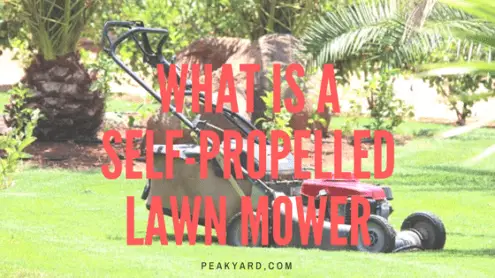If you are wondering “what is a self-propelled lawn mower?”, you are not alone. There are many people who are buying their first lawn mower or even people who have had some experience maintaining a lawn that have the same question. Admittedly, the variety of lawn mowers available today makes it super confusing to determine what is what in terms of lawn mowers. Let’s dig into what exactly is a self-propelled lawn mower.
Table of Contents
What is a Self-Propelled Lawn Mower?
A self-propelled lawn mower is a mower that moves without having to physically push it. This mower typically has a bar on the handle that you push down to activate the wheels to start to spin. The spinning wheels propel the mower forward. The operator simply walks behind the lawn mower to guide it in a straight path. To stop the lawn mower from propelling forward, the operator release the handle to stop the wheels from turning.
You can think of a self-propelled lawn mower as being somewhat similar to driving car. With this type of lawn mower, you push down a handle to make the mower move just like you would push the gas pedal to make a car drive forward. To stop the mower you release the handle. Unlike a car, a lawn mower does not have a separate brake.
Why Buy a Self-Propelled Lawn Mower
A self-propelled lawn mower takes a lot of the physical effort out of mowing a lawn. You can image how physically challenging it could be to mow a large lawn with a push mower that requires the operator to physically push the mower to make it move. If your lawn is larger than 1/4 acre, you should strongly consider getting a self-propelled lawn mower to help minimize the physical effort involved in mowing. We fully believe in getting outside for exercise, but at about 1/4 acre it starts to become unrealistic for a person to exhaust themselves from having to push mow their lawn on a weekly basis. Push mowers should typically be reserved for small yards, while large yard homeowners can benefits from a self-propelled mower. When a yard exceeds 3/4 to 1 acre, you can look at riding mowers as an option.
Features of Self-Propelled Mowers
Not all self-propelled lawn mowers are the same. The features they offer vary from mower to mower. Below is a list of potential features that a self-propelled mower may include.
- Variable Speed – The speed of the mower can be adjust faster or slower depending on the user’s preference.
- Single Speed – If the lawn mower is not equipped with variable speed, the speed will be set at a single speed by the manufacturer that is comfortable for most users.
- 3-in-1 – If you see a lawn mower labeled as “3-in-1” or “3-N-1”, this means that it can mulch, side discharge, or bag. You have the option to cut the grass in one of these three ways. If the mower is not a 3-in-1, you will be limited to one or two mowing methods.
- Electric Start – This feature allows you to turn a key or push a button to start the mower. There is no need to pull start the mower.
- Pull Start – If your lawn mower does not have a key start, you will have to pull a cord to start the lawn mower.
- Cutting Heights – Most mowers allow you to adjust the cutting height. However, some mowers offer a wider range of heights than others. The more cutting height flexibility you have will allow you to adjust for various mowing conditions without being limited to a small selection of heights. The ease of adjusting the cutting height is also important to consider.
- Cutting Width – The typical self-propelled lawn mower has a cutting width of 21 inches. However, you can find mowers that are larger such as the Craftsman Proseries 39790 at 28 inches or smaller such as the 20 inch Power Smart DB8620. A larger cutting width allows for faster mowing.
- Automatic Choke – It use to be common to push a prime button near the engine before starting the mower. Mowers now come with a no prime/no choke feature that allows the user to bypass this step. You simply start the engine without having to prime it.
- FWD, AWD, & RWD – Self-propelled lawn mowers provide options for front-wheel drive, all-wheel drive, and rear-wheel dive. If you have a flat yard, a FWD mower will work just fine. RWD is best for lawns where traction is needed, such as a yard with slopes. AWD mowers tend to be more expensive than the other two options, but provide great traction, excellent mower balance, and are good for mowing in wet conditions.
- Storage – Lawn mowers have become much easier to store over recent years. Some lawn mowers feature simple collapsible handles and the ability to store the mower upright. If you are short on space, the storage features of a self-propelled mower may be important to you.
Self-Propelled Lawn Mower Maintenance
A self-propelled lawn mower will require occasional maintenance to keep it in optimal condition. This maintenance can typically be completed at your home without the expense of taking it to a technician. Below are examples of some of the maintenance that may be required for your mower. Follow your specific owner’s manual for the manufacturer’s recommended maintenance.
Before Each Use
- Check engine oil level
- Air intake grille cleaning
- Check tires
Every 25 Hours or Annually
- Clean air filter
- Sharpen mower blade
- Check drive belt
- Change oil
Every 100 hours
- Replace spark plug
- Service cooling system
- Replace air filter

